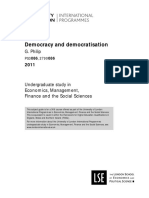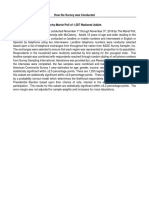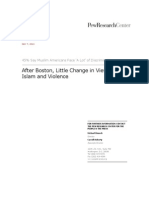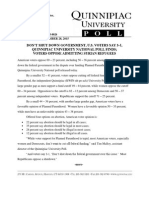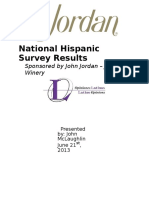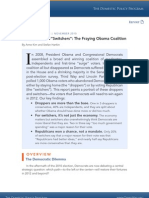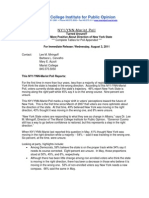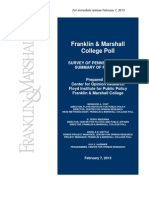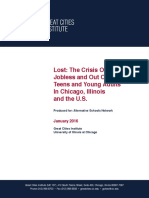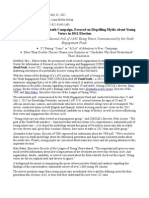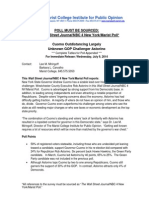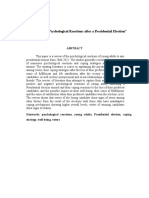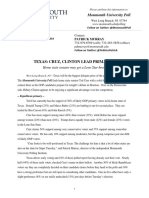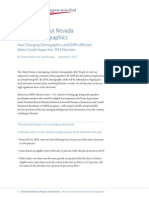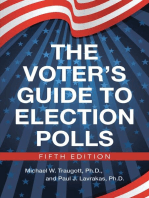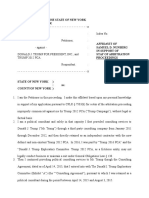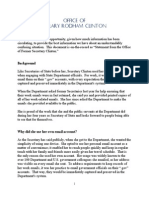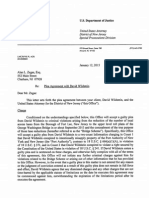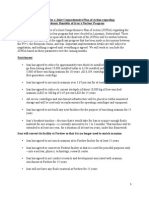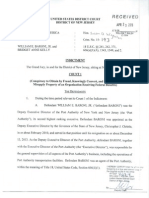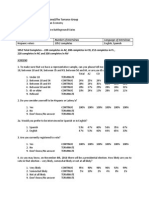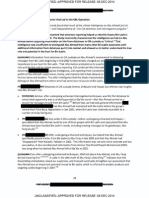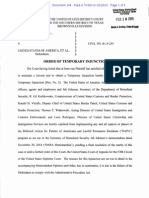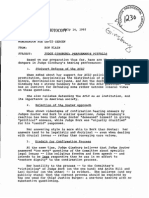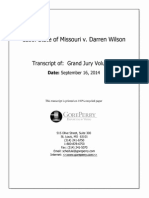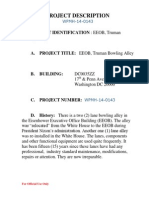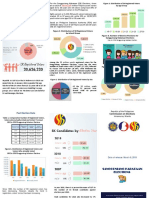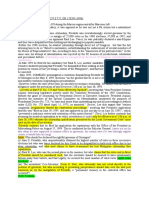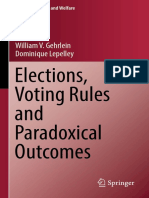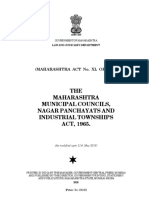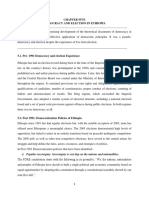Spring Poll 14 - Exec Summ EMB
Uploaded by
Zeke MillerSpring Poll 14 - Exec Summ EMB
Uploaded by
Zeke MillerEMBARGOED UNTIL 4/29/14 @ 10 AM EST
!
Survey of Young Americans Attitudes ! Toward Politics and Public Service:! 25th Edition ! ! Institute of Politics, Harvard University!
! ! ! ! ! ! ! ! ! ! ! !
!
! !
!
! Harvard Public Opinion Project!
April 29, 2014! ! ! #HarvardYouthPoll!
! ! !
The Institute of Politics! Harvard University! 79 JFK Street! Cambridge, MA 02138! (617) 495-1360"
!
"1
EMBARGOED UNTIL 4/29/14 @ 10 AM EST
Table of Contents!
!
Introduction !! Demographic and Political Prole! Political Views Related to the President, ! Midterms and 2016 !! Political Issues: Wealth Gap and Marijuana! Partisanship and Political Typology!! Trust in Institutions and Political Process! Use of Social Networking Technology!! Harvard Public Opinion Project...........!! Appendix..............!
Page 3! Page 4!
Page 5! Page 9! Page 13! Page 17! Page 20! Page 22! Page 23"
"2
EMBARGOED UNTIL 4/29/14 @ 10 AM EST
Introduction!
Conceived by two Harvard undergraduate students during the winter of 1999, Harvard Universitys Institute of Politics Survey of Young Americans Attitudes toward Politics and Public Service began in 2000 as a national survey of 18-to 24- year old college undergraduates. Over the last 13 years, this research project has grown in scope and mission, as this report now includes an analysis of 18- to 29- year olds on a broad set of longitudinal and current events issues.! The rst survey of N=800 college undergraduates was completed in the Spring of 2000 and all interviews were conducted over the telephone; since that time, 24 subsequent surveys have been released. Over this period, a number of modications have been made to the scope and methodology in order to ensure that sampling methods most accurately capture the view of the population of young adults in a manner that will be useful to both the Institute of Politics and the broader research and political communities.! In 2001, the survey was expanded from N=800 to N=1,200 college students in order to capture a more robust sample of the undergraduate population.! In 2006, the survey expanded to N=2,400 interviews, as we began interviewing members of the 18- to 24- year-old cohort who were not currently attending a four-year college or university. In addition, because of changing uses of technology among younger Americans, in 2006 the survey moved from a telephone poll to a survey that was administered online.! In 2009, we expanded our scope a third time to include the population of young adults aged 18 to 29. While we will continue to report on the attitudes and opinions of U.S. college students, this change in our research subject was made to allow for better and more direct comparisons to the broader set of election and general public opinion research tracking data, which tends to track the 18- to 29-year-old demographic group. Our fall political tracking surveys will include samples of N=2,000, while the spring semesters research will be more in-depth and include N=3,000 interviews. All of our interviews are conducted in English and Spanish. Using GfK (formerly Knowledge Networks) as our research partner, IOP surveys use RDD and AddressBased Sampling (ABS) frames and are administered online (see Appendix). !
The interviewing period for this survey of N=3,058 18- to 29- year olds was March 22 to April 4, 2014. The margin of error for the poll is +/- 1.8 percentage points at the 95 percent condence level. During the interviewing period, major media stories included searching for Malaysia Airways ight #MH370, the presidents call to end NSAs bulk data collection, extension of Obamacare deadline for those who needed it, the turmoil in Ukraine, the rst meeting between President Obama and Pope Francis, a GOP forum in Las Vegas with potential presidential candidates, news that Obamacare signups will exceed seven million and SCOTUS striking down aggregate limits on federal campaign contributions.! Harvard IOP Polling Director John Della Volpe supervised the survey group of undergraduates. As always, the IOP survey group would like to thank IOP Director Trey Grayson and Executive Director Catherine McLaughlin for their insight and support over the course of this and all IOP projects." "3
EMBARGOED UNTIL 4/29/14 @ 10 AM EST
!
Demographic prole:!
Demographic and Political Prole!
For this survey, we completed N=3,058 web-enabled interviews with 18- to 29- year-olds in the U.S.!
48 percent male, 52 percent female;! 57 percent are between the ages of 18 and 24; 43 percent are between the ages of 25 and 29;! 59 percent White (non-Hispanic), 19 percent Hispanic, 13 percent African-American (nonHispanic), 7 percent other and 2 percent 2+ races;! 20 percent are Catholic, 14 percent Protestant, 12 percent Fundamental/Evangelical, 2 percent Mormon, 2 percent Jewish, 1 percent Muslim, 10 percent another religion, 25 percent cite no religious preference and 13 percent decline to answer or say not sure;! 44 percent with a religious preference say that religion is a very important part of their life, 35 percent say that it is somewhat important and 17 percent say it is not very important;! 18 percent are married, 11 percent are living with a partner, 1 percent are divorced, 1 percent are separated and 69 percent have never been married.!
Current educational status:! 7 percent of the sample indicated that they are in high school, 2 percent in a trade or vocational school, 11 percent are in a two-year junior or community college, 21 percent in a four-year college, 5 percent in graduate school, 1 percent in a business or professional school, 1 percent are not enrolled but taking at least one class and 54 percent of 18- to 29- year olds surveyed are not enrolled in any of these categories;! 71 percent of college students attend a public institution, 29 percent a private one.!
Political and ideological prole:! 68 percent say they are registered to vote;! 19 percent consider themselves to be politically engaged or active;! 36 percent self-identify as liberal or leaning liberal, 30 percent moderate, and 32 percent conservative or leaning conservative;! 37 percent consider themselves Democrats, 25 percent Republicans, and 38 percent Independents.!
Employment status:! 55 percent are working as a paid employee, 3 percent are self-employed, and 21 percent are looking for work." "4
EMBARGOED UNTIL 4/29/14 @ 10 AM EST
Political Views Related to the President, Midterms and 2016 !
Obama Job Approval Improves to 47 Percent from Lows of 2013! The approval rating of President Obama has increased by six-percentage points (from 41% to 47%) since November 2013, the time period when our last survey of young Americans between 18- and 29years old was conducted. Rebounding from a previous low of 41 percent, the president saw steady gains across most of the major 18- to 29- year old subgroups that were analyzed, although in most every case, his approval rating remained below 50 percent. President Obamas approval rating is buoyed by the steady support of the Black community (83% approve) and the solid support of a volatile (i.e., nine-point swing in one year, 21-point swing in ve years) Hispanic community (60%); among Whites between 18- and 29- years old, the presidents approval rating is 33 percent. !
O B A M A A P P R O VA L R AT I N G ! BY SUBGROUP!
NOV 2009 ALL 18-29 18-24 25-29 COLLEGE DEM. REP. IND. WHITE BLACK HISPANIC MALE FEMALE 58% 60% 56% 57% 86% 21% 49% 48% 84% 81% 56% 60%
FEB 2010 56% 55% 57% 60% 84% 21% 49% 45% 83% 69% 53% 59%
OCT 2010 49% 48% 52% 51% 79% 18% 42% 37% 83% 62% 47% 52%
FEB 2011 55% 55% 55% 60% 81% 17% 46% 44% 83% 68% 52% 57%
DEC 2011 46% 44% 47% 48% 74% 15% 39% 35% 83% 52% 44% 48%
MAR 2012 52% 50% 55% 52% 81% 18% 40% 41% 82% 66% 50% 54%
OCT 2012 52% 50% 55% 49% 87% 12% 46% 40% 86% 70% 51% 53%
APR! 2013 52% 51% 54% 50% 86% 10% 46% 38% 84% 71% 50% 55%
NOV! 2013 41% 39% 43% 39% 79% 7% 31% 28% 75% 53% 41% 40%
APR 2014 47% 45% 48% 47% 79% 12% 38% 33% 83% 60% 45% 48%
Compared to the rst poll we conducted during the 2010 midterm election cycle, the presidents approval rating during this midterm cycle among 18- to 29-year olds is down nine percentage points overall, down 12 points among young Whites and nine points among young Hispanic and Latinos. Among Black voters there has been no change.! As the chart below indicates, the relative position of Republicans in Congress is similar, although they start from a base of support approximately half the size of the presidents. Compared to February 2010, "5
EMBARGOED UNTIL 4/29/14 @ 10 AM EST
those who approve of the job Republicans are doing in Congress declined nine points from 32 percent to 23 percent. Democrats in Congress on the other hand, track more closely to 2010, with 37 percent approval today compared to 39 percent approval four years ago.!
DO YOU APPROVE OR DISAPPROVE OF THE JOB PERFORMANCE OF ____:! - - A P P R O VA L R AT I N G S - - !
Barack Obama 58% 48% 35% 56% 49% 42% 32% 39% 28%
10/10
Democrats in Congress 55% 46% 45% 30%
2/11
Republicans in Congress
52%
52% 41% 23%
10/12
52% 41% 40% 27% 19%
4/13 11/13
47% 37% 23%
4/14
33% 24%
12/11
39% 25%
3/12
35%
11/09
2/10
!
Mood of the Country is More Positive than in Fall, Still Not Back to Spring 2013 Levels! While there are still more than twice as many young Americans believing that things in the nation are off on the wrong track (45%) rather than the right direction (21%), this ratio stands as marked improvement compared to our December 2013 release when the wrong track to right direction ratio stood at more than three (49%) to one (14%). Currently, an additional 34 percent say they are not sure which direction the country is headed. Among Democrats, 37 percent say the nation is headed in the right direction (24% wrong track), while only nine percent of Republicans feel the same way (73% wrong track).!
A L L I N A L L , D O Y O U T H I N K T H I N G S I N T H E N AT I O N A R E ?
Right direction 52% 37% 36% 23% 39% 39% 43% 41%
Wrong track 49%
42%
45%
23%
18%
10/10
20% 12%
2/11 12/11
20%
3/12
25%
25% 14%
21%
4/14
11/09
2/10
10/12
4/13
11/13
!
"6
EMBARGOED UNTIL 4/29/14 @ 10 AM EST
Obamas Health Care Approval Rating Increased 5 Points to 39 Percent! Tracking with his overall ratings, President Obamas job approval across a range of issues has also improved since last falls release, though all are lower than they were one year ago. The president receives the highest marks for the way he is handling climate change, with a 47 percent approval rating for that issue. Of note, his performance on health care rebounded ve points to 39 percent while his ratings on the economy (33% to 37% approval) and the federal budget decit (28% to 31%) increased four and three points. Thirty-eight percent (38%) of young Americans under 30 approve of the way that the president is handling the situation in Ukraine.! ! Interest in Midterm Voting Lags Behind 2010 Levels, Conservatives More Enthusiastic! Despite what seems like growing approval for the president, the Democrats and Republicans in Congress among 18- to 29- year olds, the percentage of young people who are likely to vote in the midterm elections is shrinking relative to the last time we asked the question ve months ago, and also compared to four years ago at this time. Currently, less than one-in-four (23%) young Americans under the age of 30 say that they will denitely be voting, in the upcoming midterm elections for Congress, a sharp decrease of 10 percentage points since the Fall. During a similar time of the year in 2010, 31 percent of 18- to 29- year olds reported that they would denitely vote. According to U.S. Census Bureau estimates summarized by CIRCLE1, 24 percent of 18- to 29- year olds voted in the 2010 elections, a decrease of 1.5 points from 2006 when 25.5 percent participated.!
H O W L I K E LY I S I T T H AT Y O U W I L L V O T E I N T H E M I D T E R M E L E C T I O N S F O R C O N G R E S S ? !
Denitely will be voting
36%
31%
34% 23%
Nov 2009
Feb 2010
Nov 2013
Apr 2014
Currently, there seems to be more enthusiasm for midterm voting among traditional Republican consistencies than Democratic ones. For example, 44 percent of those who voted for Mitt Romney in 2012 say they are denitely voting, which is a statistically signicant difference compared to the 35 percent of 2012 Obama voters who say the same. Additionally, self-identied conservatives (32%) are 10 points more likely to vote than liberals (22%), men (28%) are nine points more likely to vote than women (19%), and young Whites (27%) are more likely to vote than Blacks (19%) and Hispanics (19%).!
1
http://www.civicyouth.org//wp-content/uploads/2011/04/The-CPS-youth-vote-2010-FS-FINAL1.pdf
"7
EMBARGOED UNTIL 4/29/14 @ 10 AM EST
Looking Ahead, Hillary Clintons Favorability Rating Stands at 52 Percent! Looking ahead to 2016, we asked young Americans two questions each about Hillary Clinton and Chris Christie. Hillary Clinton holds a favorable rating of 52 percent (15% very favorable, 37% somewhat favorable) and an unfavorable rating of 42 percent (19% very unfavorable, 23% somewhat unfavorable). There is a 10-point gender gap, as her favorability rating among 18- to 29- year old women is 57 percent (38% unfavorable) and 47 percent among men (47% unfavorable). Her strongest constituencies include:! Older Millennials 25- to 29- years old (57% favorable, 39% unfavorable) compared to 18- to 24- year olds (49% favorable, 44% unfavorable);! Blacks (77% favorable, 18% unfavorable) and Hispanics (61% favorable, 30% unfavorable) compared to Whites (43% favorable, 53% unfavorable); and! Liberals (78% favorable, 18% unfavorable) and moderates (52% favorable, 42% unfavorable) compared to conservatives (26% favorable, 70% unfavorable).! Among Democrats, former Secretary Clintons favorable rating is 80 percent (50% being somewhat favorable), among Independents it is 47 percent and its 20 percent among Republicans. ! Over the last year, more than two-thirds (67%) of those who are familiar with former Secretary Clinton say that their opinion of her has stayed the same, approximately equal numbers say it has gotten better (17%) as has gotten worse (16%).! Alternatively, when this same question was asked of New Jersey Governor Chris Christie, more than ve times as many said their opinion had gotten worse than said better. Forty-three (43%) percent of those familiar with him say their opinion of the governor has gotten worse over the last year, less than one-in-ten (8%) responded that it got better. A plurality (49%) reported that it stayed about the same.! Overall, 62 percent of 18- to 29- year olds indicated that they had heard of Governor Christie. His favorable rating is 21 percent (3% very favorable, 18% somewhat favorable) and his unfavorable rating is nearly twice as high, 39 percent (13% very favorable, 26% somewhat favorable).!
!
O V E R T H E L A S T Y E A R , W O U L D Y O U S AY Y O U R O P I N I O N O F H I L L A RY C L I N T O N / ! C H R I S C H R I S T I E H A S G O T T E N B E T T E R , G O T T E N W O R S E , O R S TAY E D A B O U T T H E S A M E ? !
! !
Hillary Clinton
Chris Christie
Better! 17% Worse! 16% Same! 49%
Better! 8% Worse! 43%
Same! 66%
"8
EMBARGOED UNTIL 4/29/14 @ 10 AM EST
Political Issues: Wealth Gap and Marijuana!
Nearly Two-Third See Income Gap Growing, Parties Divided on Root Cause! Sixty-four percent (64%) of young Americans under 30, and a solid majority of Democrats and Republicans believe that the gap between the rich and everyone else in America is greater today than when they were born. A majority (52%) of young Americans consider this gap to be a major problem, while an additional 20 percent consider the issue to be a minor problem. Thirteen percent (13%) do not believe this to be a problem, and another 14 percent are unsure. This issue, which can prove to be highly divisive stands slightly behind the issue of student debt in the minds of 18- to 29- year old Millennials. In our fall 2013 release, it was reported that 57 percent believed student debt to be a major problem, 22 percent a minor problem and only four percent not a problem. Overall, 72 percent believe the income gap to be a problem in America, 79 percent say the same about student debt. While these two issues seem to be of serious concern to a majority of this important electoral cohort, student debt is an issue that unites members of the two parties, while debate about the income gap can quickly divide.! !
P E R C E N T W H O S AY T H AT E A C H I S A M A J O R P R O B L E M !
Democrat
Republican
62%
57%
65%
33%
Student debt
Gap in income between rich and everyone else
Another example of what appears to be a fundamental difference between the two parties is the way each thinks about the potential root causes of income disparity. For example:! Forty-four percent (44%) of Democrats believe that the gap in income is more the result of factors outside ones control, compared to 29 percent of Republicans who believe the same;! While 47 percent of Republicans believe that the gap is more the result of certain people working hard and making smart choices, compared to 29 percent of Democrats.! In addition to these differences by political party, the root causes of income disparity also result in cleavages by gender and age. Young men (37%) are signicantly more likely than young women (28%) to believe that the gap is more the result of certain people working hard and making smart choices; 18to 24- year olds (35%) are more likely than 25- to 29- year olds (29%) to believe the same. While a
"9
EMBARGOED UNTIL 4/29/14 @ 10 AM EST
plurality (44%) of Democrats seem willing to pin most of the political responsibility for this on the Republican party, only 16 percent of Republicans blame Democrats. Republicans (44%) are far more likely to shoulder some responsibility and blame both parties equally.! Young Americans Seeking Better Solutions from Both Parties to Solve the Wealth Gap! Asked to assess how effective six different policy solutions proposed by national Democrats or Republicans would be at reducing the wealth gap, young Americans expressed tepid belief in all six. None of the six options were rated as likely to be effective by more than 50 percent of respondents. Of the six options offered, raising the federal minimum wage to $10.10 was rated as likely to be effective by the largest portion of young Americans (19% very effective, 27% somewhat effective) and making it easier to form and join unions was least likely to be rated as likely to succeed (10% very effective, 21% somewhat effective). Other responses included:! Reducing workplace discrimination based on gender and race, 18 percent very effective, 28 percent somewhat effective; ! Increasing access to high-quality pre-school, 14 percent very effective, 26 percent somewhat effective;! Strengthening families and increasing the percentage of low-income parents who get married, 13 percent very effective, 25 percent somewhat effective;! Allowing parents more choice in where to send their children through school vouchers and more access to charter schools, 14 percent very effective, 31 percent somewhat effective.! Republicans favored increasing school choice through vouchers and charter schools the most (51% effective), while Democrats favored raising the minimum wage to $10.10 the most (63%). Republicans are more likely than Democrats to believe government would be ineffective in trying to close the wealth inequality gap. Additionally, a greater percentage of Republicans than Democrats rated potential policy solutions as ineffective in all six cases, with the difference being statistically signicant in four out of six cases. ! Not Quite Half of Under-30 Crowd Support Legalization of Marijuana; Signicant Differences By Party, Age and Gender Emerge! The opinion of 18- to 29- year olds related to the legalization of marijuana has remained unchanged since the last time that we asked this question in the spring of 2013. When 18- to 29- year olds were asked whether they support, oppose or are unsure about legalizing marijuana we found that 44 percent support legalization (23% strongly support, 21% somewhat support), 34 percent oppose (23% strongly oppose, 11% somewhat oppose) and 22 percent are unsure the exact same percentages across the board as one year ago. Recently, other polls have asked similar but not the same question about marijuana. Through analysis of recent polling data from the Pew Research Center2 which asked Should marijuana be legal? Yes or No, it was reported that 70 percent responded Yes and 29
2
http://www.people-press.org/2014/04/02/section-2-views-of-marijuana-legalization-decriminalization-concerns/
"1 0
EMBARGOED UNTIL 4/29/14 @ 10 AM EST
responded No. We believe that the legalization of marijuana is a complex and nuanced issue while we cannot make direct comparisons between our data and Pew data, our interpretation from both polls is that by a margin of not quite two to one, the self-proclaimed 22 percent of unsure voters in our poll would favor legalization if asked the question in a binary manner.! Despite a solid level of support in favor of legalization, support is not widespread and there are a number of notable differences in opinion on this issue that are worth noting. For example:! Democrats support legalization 49 percent to 28 percent (oppose), Republicans oppose, 32 (support) percent to 50 percent;! Younger Millennials ages 18- to- 24- years old are less sure about legalization, 38 percent support, 39 percent oppose, 22 percent unsure while 25- to 29- year olds support by a margin of 50 percent to 28 percent (21 percent unsure);! Whites support legalization 49 percent to 32 percent, while Blacks (38% support, 36% oppose) and Hispanics (37% percent, 37%) are close to even.! !
D O Y O U S U P P O RT O R O P P O S E L E G A L I Z I N G M A R I J U A N A ? !
Support
Oppose
49% 28%
50% 32% 38%39%
50% 38%
49% 32% 38%36% 37%37%
Democrat Republican
18-24
25-29
White
Black
Hispanic
Among the 10 percent of young Americans in our survey who report having used marijuana in the last few months, not surprisingly 88 percent support legalization; among those who have not used the drug in the last few months, 37 percent support legalization, 39 percent oppose legalization with 23 percent unsure, or on the fence.! When the question is changed to legalization for medical purposes, a majority of most every subgroup of 18- to 29- year olds support, including by party, gender, and age. Overall, two-thirds (66%) would support this measure, 14 percent would oppose and the percentage of young people saying they are unsure is 19 percent.! ! !
"1 1
EMBARGOED UNTIL 4/29/14 @ 10 AM EST
Among Those Who Havent Used Marijuana Recently, Nearly Nine-in-Ten Say They Are Unlikely to Change Behavior if Marijuana Legalization Passed! When those who have not used marijuana in the last few months were asked if legalization would cause them to use it, 12 percent (with rounding) said that they denitely (2%) or probably would (9%) use it, and 88 percent said they would denitely not (64%) or probably not (24%) use it.! Asked how their perception of a friend might change if they learned that friend used marijuana recreationally, 65 percent of 18- to 29- year olds said that it would not change their perception of them. Three in ten (30%) percent of respondents however said that their perception of a friend would change negatively, compared to 5 percent who said it would change positively. ! Unclear if Marijuana is a Major Driver of Participation! Approximately one-in-four young (23%) Americans agree with the statement that they would be more likely to vote in an election where legalizing marijuana were on the ballot, and 32 percent disagreed. The plurality (43%) of 18- to 24- year olds report that they neither agree or disagree with this statement, essentially saying that it is a non-factor. There was no statistical difference in the number of Democrats (26%) who agreed with the statement compared to Republicans (21%)."
"1 2
EMBARGOED UNTIL 4/29/14 @ 10 AM EST
Partisanship and Political Typology!
!
Subtle Shifts Between 2010 and 2014 Election Cycle Are Evident Among 18- to 24- Year Olds! Compared to the last midterm cycle when we used the KnowledgePanel methodology for our survey, we nd that political party afliation and self-identied ideology of young Americans under the age of 30 years old to be generally stable. In 2010, 36 percent of 18- to 29- year olds afliated with the Democratic Party and 23 percent with the Republican party; in 2014, 37 percent afliate with the Democrats and 24 percent with Republicans. The Independents in 2010 were 40 percent, today they represent 38 percent. However, when 18- 24- year olds and 25- to 29- year olds from 2010 are compared to their same cohorts in 2014, we see subtle shifts. For example, as the table below indicates, Democrats have gained ve percentage points among 25- to 29- year olds since the last midterm cycle, while they have lost three points among 18- to 24- year olds. Where younger Millennials once held a 15-point Democrat to Republican margin, we now see this margin shifting to 25- to 29- year olds, while the 18-to 24- year olds margin is shrinking." !
PA RT Y I D E N T I F I C AT I O N B Y A G E ! 2010 VS. 2014
SPRING 2010
SPRING 2014
18-24 DEMOCRAT REPUBLICAN INDEPENDENT DEMOCRATIC-REPUBLICAN! ADVANTAGE 38% 23% 37% +15
25-29 34% 22% 42% +12
18-24 35% 25% 40% +10
25-29 39% 24% 36% +15
Since 2010, we have also noted that there has been a three-percentage point increase in the number of 18- to 29- year olds who call themselves moderate all of that change coming from the youngest cohort (18- to 24- year olds) who in 2010 were 39 percent liberal, 36 percent conservative and 26 moderate; they now consider themselves to be 35 percent liberal, 33 percent conservative and 31 moderate. !
! !
"1 3
EMBARGOED UNTIL 4/29/14 @ 10 AM EST
Political Typology, Where Democrats and Republicans Converge (and Where They Dont)! With income inequality and marijuana just two of the pressing issues that illustrate some of the fundamental differences in belief between young Democrats and Republicans today, below is analysis that compares Democrats and Republicans across a spectrum of 15 issues that help form the political typology of this generation. Most of the questions were drafted a decade ago by Harvard undergraduates participating in the Institute of Politics polling program and remain relevant today. Each question is designed on a ve-point scale, with strong agreement being a one and strong disagreement a ve. As illustrated in the chart below, young Americans of opposing parties are closely aligned only on school choice and privacy policy, and their opinions diverge on issues related to health insurance, same-sex relationships, the role of government welfare, afrmative action and climate change.!
!
P O L I T I C A L T Y P O L O G Y O F D E M O C R AT S A N D R E P U B L I C A N S R A N K E D B Y L E V E L ! O F A G R E E M E N T B E T W E E N PA RT I E S ( 1 = S T R O N G LY A G R E E - 5 = S T R O N G LY D I S A G R E E ) "
Democrat
Republican
2.84 2.83 3.11 3.19 2.92 3.17 3.51 3.13 2.92 2.47 2.9 3.51 3.78 2.92 2.78 3.67 2.85 1.94 2.65 3.56 3.2 4.12 2.34 3.29 2.41 3.37 3.83 2.72 2.23 3.47
If parentschoose where they could send their children to school... I am willing to give up someprivacy for the sake of national security. Our country's goal...should be to eliminate all barriers to trade... In today's world, it is sometimes necessary to attack potentially hostile countries... Cutting taxes is an effective way to increase economic growth. Recent immigration into this country has done more good than harm. Religious values should play a more important role in government. Government spending is an effective way to increase economic growth. I am concerned about the moral direction of the country. Government should do more to curb climate change... Qualied minorities should be given special preferences in hiring and education. Basic necessities...are a right that government should provide... The government should spend more to reduce poverty. Homosexual relationships are morally wrong. Basic health insurance is a right for all people... 1
Agree
Disagree
"1 4
EMBARGOED UNTIL 4/29/14 @ 10 AM EST
Millennials Views Toward Privacy, Foreign Policy, Afrmative Action Have Shifted Since 2010! When the responses of these 15 questions are compared with responses from our spring 2010 poll, we found that young Democrats and Republicans are more closely aligned on their views toward privacy and foreign policy:! I am willing to give up some personal freedom and privacy for the sake of national security since 2010, we have found that Republicans have become less willing to give up personal freedom and privacy, therefore tacking closer to the Democratic position. In 2010, the mean score on a scale from one (strongly agree) to ve (strongly disagree) for Republicans was 2.92, in 2014 it is 3.19 (meaning more disagreement). For Democrats in 2010, the score was 3.18, now its is 3.11.! In today's world, it is sometimes necessary to attack potentially hostile countries, rather than waiting until we are attacked to respond since 2010, we have found that both Republicans and Democratic are more likely to disagree with this position, often referred to as the Bush Doctrine. In 2010, the mean score on a scale from one (strongly agree) to ve (strongly disagree) for Republicans was 2.73, in 2014 it is 3.13 (meaning more disagreement). For Democrats in 2010, the score was 3.34, now its is 3.51.! Conversely, they are less aligned on issues related to immigration, afrmative action and the moral direction of the country: ! Qualied minorities should be given special preferences in hiring and education since 2010, Democrats (3.36 in 2010, now 3.2) are more likely to agree with this position and Republicans (4.07 in 2010, now 4.12) are more likely to disagree.! Recent immigration into this country has done more good than harm since 2010, Democrats (3.17 in 2010, now 2.9) are more likely to agree with this position and Republicans (3.4 in 2010, now 3.51) are more likely to disagree.! I am concerned about the moral direction of the country since 2010, Democrats (2.61 in 2010, now 2.85) are less likely to agree with this position and Republicans are statistically at the same place (1.97 in 2010, now 1.94). Majority of 18- to 29- Year Olds Agree That Sexual Orientation Of A Friend Is Not Important ! In addition to our focus on the income gap between the rich and everyone else, and the legalization of marijuana, our students probed on topics related to diversity, including sexual orientation and afrmative action in education. In the past year, eight states have legalized gay marriage by either state legislature or court decision, bringing the total number of states who recognize same-sex marriage to 17 states. This growing movement to legalize same-sex marriage is reected in young Americans attitudes towards sexual orientation. Sixty-one percent (61%) of young Americans agree that a friends sexual orientation is not important to them, while only 14 percent disagree. Women are six percentage points more likely to state that a friends sexual orientation is not important to them than men (64% to 58%). !
"1 5
EMBARGOED UNTIL 4/29/14 @ 10 AM EST
Blacks and Hispanics Signicantly More Likely Than Whites To Agree That Racial Diversity Is Important In College Education. ! With recent Supreme Court cases such as Michigans Schuette v. Coalition to Defend Afrmative Action and Fisher v. University of Texas, revelations at Ole Miss, and most recently, the dialogue ignited by I, Too, Am Harvard, racial diversity on college campuses has remained a prevalent issue. Blacks (43%) and Hispanics (43%) are 14 percentage points more likely to agree than Whites (29%) that racial diversity is important to the quality of a college education. Those who identify as other races (50%) saw an even larger gap in agreement with Whites (21 percentage points). Conversely, three times as many Whites (25%) disagree with this statement than Blacks (8%). !
! !
"1 6
EMBARGOED UNTIL 4/29/14 @ 10 AM EST
Trust in Institutions and the Political Process!
!
Levels of Trust Continue to Slide Across there Board, All Institutions Below 50%! Compared to one year ago, the level of trust that young Americans between 18- and 29- years old have in most American institutions tested in our survey has dissipated compared even to last years historically low numbers. For example, in the last 12 months, trust in the President has decreased from 39 percent to 32 percent, the U.S. military has decreased from 54 percent to 47 percent (the rst time below a majority) and the Supreme Court from 40 to 36 percent. Below is a graph that charts the composite trust index (an average of six public institutions tracked using the same methodology) since 2010. " !
C O M P O S I T E T R U S T I N D E X 3: ! P R E S I D E N T, U S M I L I TA RY, C O N G R E S S , S U P R E M E C O U RT, ! F E D E R A L G O V E R N M E N T, U N I T E D N AT I O N S !
39% 37%
38% 35% 31%
2/10
2/11
3/12
4/13
4/14
!
The level of trust that young Americans have in the President and the U.S. Military has suffered the most over the last year. The growing lack of trust in the President comes from Democrats (64% trusted the President to do the right thing all or most of the time in 2013, today the number is 53%) and Independents (31% in 2013, 23% today) and not from Republicans whose opinion has not changed in the last year. Thirteen percent (13%) of Republicans trust the President to do the right thing all or most of the time. ! These ndings stand in contrast to the U.S. Military; over the last year, the military has lost trust across all parties (Democrats are down 6 points to 44%, Republicans 5 points to 63% and Independents down 8 points to 40%)."
Composite trust index is the average percentage of those who trust each institution to do the right thing all or most of the time.
"1 7
EMBARGOED UNTIL 4/29/14 @ 10 AM EST
B E L O W I S A S H O RT L I S T O F I N S T I T U T I O N S , H O W O F T E N D O Y O U ! TRUST EACH OF THEM TO DO THE RIGHT THING?! % WHO RESPOND ALL OR MOST OF THE TIME !
FEB 2010
FEB 2011
MAR 2012
APR 2013
APR 2014
THE PRESIDENT THE US MILITARY THE CONGRESS THE SUPREME COURT THE FEDERAL GOVERNMENT THE UNITED NATIONS YOUR STATE GOVERNMENT YOUR LOCAL GOVERNMENT WALL STREET THE MEDIA THE NSA
44% 53% 25% 45% 29% 40% 11%* 17%* -
41% 50% 23% 44% 27% 38% 28% 33% -
41% 55% 23% 45% 27% 38% 32% 37% 13% -
39% 54% 18% 40% 22% 34% 30% 34% 12% 11% -
32% 47% 14% 36% 20% 34% 28% 33% 12% 11% 24%
In 2010, the question asked about Wall Street executives and traditional media.!
!
Appeal and Effectiveness of Politics Also on Decline! While we have seen a consistent and across the board drop in trust levels for some time, we also see a similar pattern on issues relation to the efcacy of the political process more generally. For example, since 2010, there has been a consistent six-point increase in those who agree with the statement that elected ofcials seem to be motivated by selsh reasons, more than three-in-ve (62%) now agree with this; and a similar six-point increase with agreement that political involvement rarely has any tangible results (23% in 2010, 29% in 2014). ! We also have tracked a seven-point increase in the number who agree with the statement, elected ofcials dont seem to have the same priorities I have (51% in 2010, 58% in 2014)."
"1 8
EMBARGOED UNTIL 4/29/14 @ 10 AM EST
D O Y O U A G R E E O R D I S A G R E E W I T H E A C H S TAT E M E N T ? ! % W H O A G R E E S T R O N G LY O R S O M E W H AT !
FEB 2010
FEB 2011
MAR 2012
APR 2013
APR 2014
COMMUNITY SERVICE IS AN HONORABLE THING TO DO ELECTED OFFICIALS SEEM TO BE MOTIVATED BY SELFISH REASONS ELECTED OFFICIALS DONT SEEM TO HAVE THE SAME PRIORITIES I HAVE POLITICS HAS BECOME TOO PARTISAN POLITICS TODAY ARE NO LONGER ABLE TO MEET THE CHALLENGES OUR COUNTRY IS FACING PEOPLE LIKE ME DON'T HAVE ANY SAY ABOUT WHAT THE GOVERNMENT DOES RUNNING FOR OFFICE IS AN HONORABLE THING TO DO POLITICAL INVOLVEMENT RARELY HAS ANY TANGIBLE RESULTS THE IDEA OF WORKING IN SOME FORM OF PUBLIC SERVICE IS APPEALING TO ME
70%
69%
69%
70%
70%
54%
55%
59%
59%
62%
51%
55%
56%
58%
46%
44%
49%
48%
49%
45%
47%
48%
36%
35%
37%
37%
41%
35%
36%
35%
35%
32%
23%
24%
29%
28%
29%
33%
33%
31%
31%
29%
"1 9
EMBARGOED UNTIL 4/29/14 @ 10 AM EST
Use of Social Networking Technology! "
Facebook Remains the Dominant Platform, but Education, Race and Political Party Play Role in Social Network Preferences! The use of most social networking platforms and communications tools increased since our last poll was taken in the fall of 2013 by between four and eight percentage points. For example, the percentage of 18- to 29- year olds who have a:! Facebook account grew from 79 percent to 84 percent;! Google+ account growth expanded from 37 percent to 44 percent;! Twitter growth increased from 35 percent to 40 percent;! Instagram from 30 percent to 36 percent;! Pinterest from 25 percent to 33 percent;! Snapchat from 16 percent to 23 percent; and ! Tumblr from 10 percent to 14 percent.! With slightly more than three-in-ve (61%) students in graduate school having a Google+ account, use among this cohort is signicantly higher than students in high school (40%), college (41%), or those who are not in college and never attended (41%). Google+ is also more popular among young Blacks (54%) than young Whites under 30 years old. ! Facebook (87%), Twitter (47%), Instagram (45%), Pinterest (37%), Snapchat (34%) and Tumblr (19%) are all more popular among college students than among young Americans who are not in, or never have attended, college.! When we asked the open-ended question, What is the one website, social network, or app that you could not live without? we found that while Facebook was the overall winner by a signicant margin (24% compared to 7% for the second most mentioned site, Google), there were signicant differences based on what level of education one was enrolled in. For example, high school students were signicantly more likely to not tell us that Twitter was the platform that they could not live without. While the number of interviews was less than 200, this was a statistical signicant nding when compared to students in community colleges and graduate school.!
!
! ! ! ! "2 0
EMBARGOED UNTIL 4/29/14 @ 10 AM EST
W H AT I S T H E O N E W E B S I T E , S O C I A L N E T W O R K , O R A P P ! T H AT Y O U C O U L D N O T L I V E W I T H O U T ? ! - B Y C U R R E N T E D U C AT I O N S TAT U S - !
ALL ! 18-29! N=3,058 FACEBOOK GOOGLE TWITTER YOUTUBE INSTAGRAM 24% 7% 3% 3% 3%
HIGH SCHOOL! n=179 13% 3% 13% 9% -
2-YEAR COLLEGE! n=367 18% 9% * 1% 3%
4-YEAR COLLEGE! n=626 22% 6% 7% 5% 6%
GRADUATE SCHOOL! n=194 25% 15% 2% * 2%
Partisanship and Social Networks ! We also see similar differences when social platform use is analyzed across party lines. While Facebook seems to have the same number of Democrats (87%) as Republicans (87%) Google+ (52% of Democrats have an account compared to 36% of Republicans) and Twitter (46% of Democrats have an account compared to 38% of Republicans) seem to trend more Democratic. Pinterest, on the other hand, trends more Republican (40% have an account compared to 32% of Democrats). !
O N W H I C H O F T H E F O L L O W I N G P L AT F O R M S D O Y O U H AV E A N A C C O U N T ? ! - B Y P O L I T I C A L PA RT Y - "
Democrat Facebook Google+ Twitter Instagram Pinterest Snapchat Tumblr WhatsApp FourSquare
7% 11% 6% 7% 5% 24% 23% 18%
Republican
87% 87% 52% 36% 46% 38% 41% 37% 32% 40%
"2 1
EMBARGOED UNTIL 4/29/14 @ 10 AM EST
Harvard Public Opinion Project !
"
Harvards Institute of Politics (IOP) was established in 1966 as a memorial to President Kennedy and aims to inspire undergraduates to consider careers in politics and public service. The Institute oversees the John F. Kennedy Jr. Forum, one of the worlds premier arenas for political speech, discussion, and debate, and runs a fellowship program offering a unique opportunity for political practitioners to spend semesters at Harvard and interact with students. The IOP also offers dozens of paid internships for eight to ten weeks during the summer; a nonpartisan, quarterly journal written and run entirely by undergraduates; and a unique, nationwide survey project of young adults political views.!
Students are offered wide-ranging opportunities, including internships and conferences intended to provide opportunities for interaction with the people who shape politics and public policy. The IOP does not offer formal courses or degree-granting programs; instead, it provides avenues for practical experience and encourages students to examine critically and think creatively about politics and public issues. For more information, including past results of these polls, please visit us online at www.iop.harvard.edu.!
! Harvard Institute of Politics team members who worked on this project include:! !
Trey Grayson! ! ! ! Director, Institute of Politics! !
!
!
! !
! ! !
!
John Della Volpe! Director of Polling, Institute of Politics!
Catherine McLaughlin! ! ! Executive Director, Institute of Politics !
Esten Perez! ! Director of Communications, Institute of Politics!
The Student Chair of the Harvard Public Opinion Project Committee is Alex Wirth 15. ! Student members of the committee are: John Acton 17, Marc Bornstein 17, Kurt Bullard 17, Kathryn Bussey 17, Deniz Cataltepe 17, Jenny Choi 16, Rahul Dalal 15, Michelle Danoff 17, Colin Diersing 16, Frances Ding 17, Kate Donahue 16, Thomas Esty 14, Anjali Fernandes 17, Zoe Foulkes 17, Jenny Gao 16, Michael Gellman 17, Bella Gomez 17, Sarah Graham 17, Lauren Greenawalt 16, Ryan Grossman 15, Eva Guidarini 15 (former HPOP student chair), Melissa Hammer 17, Jake Hummer 17, Rachel Kassa 15, William Keith 16, Max Kennedy 16, Mariel Klein 17, Peter Kraft 17, Steven Lee 16, Paul Lisker 16, Zach Lustbader 16, Rhea Malik 17, Mason Marek 15, Katelyn McEvoy 17, Jacob Meisel 17, Jeff Metzger 17, Niyat Mulugheta 16, Tyler Olkowski 17, Meg Panetta 17, Allyson Perez 17, John Pulice 15, Allison Rachesky 15, Ellen Robo 16, Dan Rubin 17, Wesley Sagewalker 15, Jonathan Sands 17, Gillian Slee 16, Ved Topkar 16, Maximilian Ubias 17, Lauren Volpert 17, Jennifer Walsh 17, Susan Wang 17, Matthew Warshauer 14 (former HPOP student chair), Paul Wei 15, Kit Wu 17, Alissa Zhang 16!
!
"2 2
EMBARGOED UNTIL 4/29/14 @ 10 AM EST
Appendix!
The GfK Group (formerly Knowledge Networks) conducted a study of young adults on political issues on behalf of the Harvard University Institute of Politics. The goal of the project was to collect 3,000 completed interviews with KN panelists 18- to 29- years of age in English and Spanish. The main sample data collection took place from March 22 to April 4, 2014. A small pretest was conducted prior to the main survey to examine the accuracy of the data and the length of the interview. ! Four thousand, nine hundred and twenty-one (6,889) KnowledgePanel members were assigned to the study. The cooperation rate was 46.3 percent resulting in 3,193 completed interviews.# Of the 3,193 cases completing the main survey, 3,058 cases were determined to be valid cases to be included in the nal analyses. The 137 cases were excluded due to the fact that they refused to answer more than onethird of the substantive survey questions. Eighty-four (84) interviews were conducted in Spanish with the remainder done in English. ! Key personnel from GfK involved in this project include:! Wendy Manseld Vice President, Research Development. W. Manseld is based in Washington, D.C. ! Phone number: (202) 686-0933! Email: wendy.manseld@gfk.com! Stephanie Jwo Research Manager, Government & Academic Research. S. Jwo is based in Palo Alto.! Phone number: (650) 289-2113! Email: stephanie.jwo@gfk.com! Ying Wang Senior Research Associate, Government & Academic Research. Y. Wang is based in Palo Alto.! Phone number: (650) 289-2069! Email: ying.wang2@gfk.com!
The GfK Group (formerly Knowledge Networks) is passionate about research in marketing, media, health and social policy collaborating closely with client teams throughout the research process, while applying rigor in everything we do. We specialize in innovative online research that consistently gives leaders in business, government, and academia the condence to make important decisions. GfK has recruited the rst online research panel that is representative of the entire U.S. population. Panel members are randomly recruited through probability-based sampling, and households are provided with access to the Internet and hardware if needed.# ! GfK recruits panel members by using address-based sampling methods [formerly GfK relied on random-digit dialing methods]. Once household members are recruited for the panel and assigned to a study sample, they are notied by email for survey taking, or panelists can visit their online member page for survey taking (instead of being contacted by telephone or postal mail). This allows surveys to be elded very quickly and economically. In addition, this approach reduces the burden placed on respondents, since email notication is less intrusive than telephone calls, and most respondents nd "2 3
EMBARGOED UNTIL 4/29/14 @ 10 AM EST
answering Web questionnaires more interesting and engaging than being questioned by a telephone interviewer. Furthermore, respondents have the freedom to choose what time of day to complete their assigned survey.! Documentation regarding KnowledgePanel sampling, data collection procedures, weighting, and IRBbearing issues are available at the below online resources.! http://www.knowledgenetworks.com/ganp/reviewer-info.html! http://www.knowledgenetworks.com/knpanel/index.html! http://www.knowledgenetworks.com/ganp/irbsupport/!
The GfK Group!
The GfK Group has a strong tradition in working with sophisticated academic, government, and commercial researchers to provide high quality research, samples, and analyses. The larger GfK Group offers the fundamental knowledge for governmental agencies, academics, industries, industry, retailers, services companies and the media need to provide exceptional quality in research to make effective decisions. It delivers a comprehensive range of information and consultancy services. GfK is one of the leading survey research organizations worldwide, operating in more than 100 countries with over 11,000 research staff. In 2010, the GfK Groups sales amounted to EUR 1.29 billion. !
Panel Recruitment Methodology! When GfK began recruiting in 1999 as Knowledge Networks, the company established the rst online research panel (now called KnowledgePanel) based on probability sampling covering both the online and ofine populations in the U.S. Panel members are recruited through national random samples, originally by telephone and now almost entirely by postal mail. Households are provided with access to the Internet and a netbook computer, if needed.# Unlike Internet convenience panels, also known as opt-in panels, that include only individuals with Internet access who volunteer themselves for research, KnowledgePanel recruitment has used dual sample frames to construct the existing panel. As a result, panel members come from listed and unlisted telephone numbers, telephone and nontelephone households, and cell phone only households, as well as households with and without Internet access, which creates a representative sample.# Only persons sampled through these probability-based techniques are eligible to participate on KnowledgePanel.# Unless invited to do so as part of these national samples, no one on their own can volunteer to be on the panel.# ! RDD and ABS Sample Frames! KnowledgePanel members today may have been recruited by either the former random digit dialing (RDD) sampling or the current address-based sampling (ABS) methodologies. In this section, we will describe the RDD-based methodology; the ABS methodology is described in a separate section below. To offset attrition, multiple recruitment samples are elded evenly throughout the calendar year.!
"2 4
EMBARGOED UNTIL 4/29/14 @ 10 AM EST
KnowledgePanel recruitment methodology has used the quality standards established by selected RDD surveys conducted for the Federal government (such as the CDC-sponsored National Immunization Survey).! GfK employed list-assisted RDD sampling techniques based on a sample frame of the U.S. residential landline telephone universe.# For purposes of efciency, GfK excluded only those banks of telephone numbers (a bank consists of 100 numbers) that had fewer than two directory listings.# Additionally, an oversampling was conducted within a stratum of telephone exchanges that had high concentrations of African American and Hispanic households based on Census data. Note that recruitment sampling was done without replacement, thus numbers attempted in earlier waves were excluded from subsequent recruitment waves.# ! A telephone number for which a valid postal address can be matched occurred in about 67-70% of each sample at the time RDD was being used for recruitment.# These address-matched cases were all mailed an advance letter informing them that they had been selected to participate in the KnowledgePanel. For purposes of efciency, the numbers without a matched-physical address were under-sampled at a rate of 0.75 relative to the address-matched numbers. Both the minority oversampling mentioned above and this under-sampling of non-address households are accounted for appropriately in the in the panels weighting procedures. ! Following the mailings, telephone recruitment by professional interviewers/recruiters began for all sampled telephone numbers.# Telephone numbers for cases sent to recruiters were dialed for up to 90 days, with at least 14 dial attempts for cases in which no one answers the phone, and for numbers known to be associated with households. As occurs for most telephone interviews, for those participants who were hesitant or expressed a soft refusal, extensive refusal conversion was also performed.# The recruitment interview, about 10 minutes in length, begins with informing the household member that the household had been selected to join KnowledgePanel.# If the household did not have a computer and access to the Internet, the household member is told that, as reward for completing a short survey weekly, the household will be provided with free monthly Internet access and a laptop computer (in the past, the household was provided with a WebTV device, currently, netbooks are provided).# All members of the household were enumerated, and some initial demographic and background information on prior computer and Internet use was collected. ! Households that informed recruiters that they had a home computer and Internet access were asked to take GfK surveys using their own equipment and Internet connection.# Incentive points per survey, redeemable for cash, are given to these PC (personal computer) respondents for completing their surveys. Panel members provided with a laptop computer and free Internet access do not participate in this per-survey points-incentive program.# However, all panel members receive special incentive points for selected surveys to improve response rates and/or for all longer surveys as a modest compensation for the extra burden of their time and participation.! For those panel members receiving a laptop or netbook computer, each unit is custom-congured prior to shipment with individual email accounts so that it is ready for immediate use by the household.# Most households are able to install the hardware without additional assistance, although GfK maintains a toll-free telephone line for technical support. The GfK Call Center contacts household members who do not respond to email and attempts to restore both contact and participation. PC "2 5
EMBARGOED UNTIL 4/29/14 @ 10 AM EST
panel members provide their own email addresses, and we send their weekly survey invitations to that email account.! All new panel members receive an initial survey for the dual purpose of welcoming them as new panel members and introducing them to how online survey questionnaires work.## New panel members also complete a separate prole survey that collects essential demographic information such as gender, age, race, income, and education to create a personal member prole. This information can be used to determine eligibility for specic studies and is factored in for weighting purposes. Operationally, once the prole information is stored, it does not need to be re-collected as a part of each and every survey.# This information is also updated annually for all panel members. Once new members have completed their prole surveys, they are designated as active, and considered ready to be sampled for client studies.# [Note: Parental or legal guardian consent is also collected for the purpose of conducting surveys with teenage panel members, aged 13 to17.]! Once a household is recruited and each household members email address is either obtained or provided, panel members are sent survey invitations linked through a personalized email message (instead of by phone or postal mail). This contact method permits surveys to be elded quickly and economically, and also facilitates longitudinal research. In addition, this approach reduces the burden placed on respondents, since email notication is less intrusive than telephone calls and allows research subjects to participate in research when it is convenient for them.# ! Address-Based Sampling (ABS) Methodology! When GfK rst started panel recruitment in 1999, the conventional opinion among survey experts was that probability-based sampling could be carried out cost effectively through the use of national RDD samples. The RDD landline frame at the time allowed access to 96% of U.S. households.# Due to the rapid rise of cell phone-only households, this is no longer the case. In 2009, GfK rst used addressbased sampling for panel recruitment to reect the changes in society and telephony over recent years. Some of the factors that have reduced the long-term scientic viability of landline RDD sampling methodology are as follows: declining respondent cooperation in telephone surveys, the development of do not call lists to reduce unsolicited commercial calls, call screening with caller-ID devices, increased use of answering machines; dilution of the RDD sample frame as measured by the working telephone number rate (more fax lines and lines dedicated to other functions), and nally, the emergence of cell phone only households (CPOHH), since these households are typically excluded from the RDD frame because they have no landline telephone. ! According to the Centers for Disease Control and Prevention (January-June 2011), approximately 33.6% of all U.S. households cannot be contacted through RDD sampling31.6% as a result of CPOHH status and 2% because they have no telephone service whatsoever. Among some age segments, the RDD noncoverage would be substantial: 47% of young adults, ages 1824, reside in CPOHHs, 58% of those 25 29 years old, and 46% of those who are 3034.! After conducting an extensive pilot project in 2008, GfK made the decision to move to use an addressbased sample (ABS) frame in response to the growing number of cell phone only households that are outside the RDD frame. Before conducting the ABS pilot, we also experimented with supplementing RDD samples with cell phone samples. However, this approach was found to be much more costly, "2 6
EMBARGOED UNTIL 4/29/14 @ 10 AM EST
and raised a number of other operational, data quality, and liability issues (for example, calling cell phones while respondents were driving). ! The key advantage of the ABS sample frame is that it allows sampling of almost all U.S. households. An estimated 97% of households are covered in sampling nomenclature. Regardless of household telephone status, those households can be reached and contacted through postal mail. Second, the GfK ABS pilot project revealed several additional advantages beyond expected improvement in recruiting adults from CPOHHs:! Improved sample representativeness for minority racial and ethnic groups! Improved inclusion of lower educated and lower income households! Exclusive inclusion of the fraction of CPOHHs that have neither a landline telephone nor Internet access (approximately four to six percent of US households).!
ABS involves probability-based sampling of addresses from the U.S. Postal Services Delivery Sequence File. Randomly sampled addresses are invited to join KnowledgePanel through a series of mailings and, in some cases, telephone follow-up calls to non-responders when a telephone number can be matched to the sampled address. Operationally, invited households have the option to join the panel by one of several ways: ! Completing and returning a paper form in a postage-paid envelope,! Calling a toll-free hotline maintained by GfK, or ! Going to a dedicated GfK web site and completing an online recruitment form. !
After initially accepting the invitation to join the panel, respondents are then proled online by answering key demographic questions about themselves. This prole is maintained through the same procedures that were previously established for RDD-recruited panel members. Respondents not having an Internet connection are provided a laptop or netbook computer and free Internet service. Respondents sampled from the ABS frame, like those sampled from the RDD frame, are offered the same privacy terms and condentiality protections that we have developed over the years and that have been reviewed and approved by dozens of Institutional Review Boards.! Large-scale ABS sampling for KnowledgePanel recruitment began in April 2009. As a result, sample coverage on KnowledgePanel of CPOHHs, young adults, and minority population groups has been increasing steadily since that time. ! Because current KnowledgePanel members have been recruited over time from two different sample frames, RDD and ABS, GfK implemented several technical processes to merge samples sourced from these frames. KNs approach preserves the representative structure of the overall panel for the selection of individual client study samples. An advantage of mixing ABS frame panel members in any KnowledgePanel sample is a reduction in the variance of the weights. ABS-sourced samples tend to align more closely to the overall demographic distributions in the population, and thus the associated adjustment weights are somewhat more uniform and less varied. This variance reduction efcaciously "2 7
EMBARGOED UNTIL 4/29/14 @ 10 AM EST
attenuates the samples design effect and conrms a real advantage for study samples drawn from KnowledgePanel with its dual frame construction.! Sampling and Recruitment Procedures for KnowledgePanel Latino! In addition to the above-documented English-based panel recruitment, in 2008 GfK constructed KnowledgePanel Latino to provide researchers with the capability to conduct representative online surveys in the U.S. Hispanic community. Prior to the advent of KnowledgPanel Latino, there did not exist in anywhere in the U.S. an online panel that represented Hispanics with and without Internet access and that reached that part of the U.S. population able to participate in surveys only in Spanish. ! The sample for KnowledgePanel Latino was originally recruited through a hybrid telephone recruitment design based on a random-digit dialing sample of U.S. Latinos and Hispanic-surnames. It is a geographically balanced sample that covers areas that, when aggregated, encompasses approximately 93% of the nations 45.5 million Latinos. ! KnowledgePanel Latino sample Latinos residing in 70 DMAs having Latino populations. The DMAsampling approach (Designated Market Area) was dedicated to the recruitment of Spanish-LanguageDominant adults, having been categorized as unassimilated on the basis of frequency of viewing Spanish-language television and use of Spanish as their primary spoken language at home. The 70 DMAs are grouped into ve regions (Northeast, West, Midwest, Southeast, and Southwest). Each region is further divided into two groupings of census tracts, those that have a high-density Latino population and those remaining, which have a low-density Latino population. The threshold percent for high density varies by region. The ve regions, each divided into the two density groups, constitute 10 unique sample frames (5 x 2).! Using a geographic targeting approach, an RDD landline sample was generated to cover the highdensity census tracts within each region. Due to the inaccuracy of telephone exchange coverage, there is always some spillage outside these tracts and a smaller degree of non-coverage within these tracts. About 32% of the Latino population across these ve regions is covered theoretically by this targeted RDD landline sample. All the numbers generated were screened to locate a Latino, Spanish-speaking household.! The remaining 68% of the Latinos in these ve regions were addressed through a listed-surname sample. Listed surnames include only those households where the telephone subscriber has a surname that has been pre-identied as likely to be a Latino surname. It is important to note that excluded from this low-density listed sample frame are: (a) the mixed Latino/non-Latino households where the subscriber does not have a Latino surname and (b) all the unlisted landline Latino households. The percent of listed vs. unlisted varies at the DMA level. The use of the listed surname was intended to utilize cost-effective screening to locate Latino households in these low-density areas since the rate of nding Latino households on this list, although not 100%, is still very high.! In 2011, the above described hybrid design was replaced with national RDD samples targeting telephone exchanges that penetrate census blocks with a 45% or greater Latino population density (this density level covers just over 50% of the U.S. Hispanic population). Households are screened in the Spanish language to recruit only those homes where Spanish is spoken at least half the time. In 2012, "2 8
EMBARGOED UNTIL 4/29/14 @ 10 AM EST
the census block Hispanic density was raised to 65% to improve the eligibility efciency of this RDD approach. ! This all probability-based RDD Spanish-language sample supplements the Latino households (English and Spanish) that are now recruited through GfKs general ABS recruitment sample.! Survey Sampling from KnowledgePanel! Once panel members are recruited and proled, they become eligible for selection for client surveys. In most cases, the specic survey sample represents a simple random sample from the panel, for example, a general population survey.# Customized stratied random sampling based on prole data can also be conducted as required by the study design.! The general sampling rule is to assign no more than one survey per week to individual members. Allowing for rare exceptions during some weeks, this limits a members total assignments per month to four or six surveys. In certain cases, a survey sample calls for pre-screening, that is, members are drawn from a subsample of the panel (such as females, Republicans, grocery shoppers, etc.).# In such cases, care is taken to ensure that all subsequent survey samples drawn that week are selected in such a way as to result in a sample that remains representative of the panel distributions.# ! For this survey, a nationally representative sample of U.S. adults aged 18 to 29 was selected.! Survey Administration! Once assigned to a survey, members receive a notication email letting them know there is a new survey available for them to take. This email notication contains a link that sends them to the survey questionnaire. No login name or password is required. The eld period depends on the clients needs and can range anywhere from a few hours to several weeks. ! After three days, automatic email reminders are sent to all non-responding panel members in the sample. If email reminders do not generate a sufcient response, an automated telephone reminder call can be initiated. The usual protocol is to wait at least three to four days after the email reminder before calling. To assist panel members with their survey taking, each individual has a personalized home page that lists all the surveys that were assigned to that member and have yet to be completed. ! GfK also operates an ongoing modest incentive program to encourage participation and create member loyalty. Members can enter special rafes or can be entered into special sweepstakes with both cash rewards and other prizes to be won.! The typical survey commitment for panel members is one survey per week or four per month with duration of 10 to 15 minutes per survey. In the case of longer surveys, an additional incentive is typically provided.! Sample Weighting! The design for KnowledgePanel recruitment begins as an equal probability sample with several enhancements incorporated to improve efciency. Since any alteration in the selection process is a "2 9
EMBARGOED UNTIL 4/29/14 @ 10 AM EST
deviation from a pure equal probability sample design, statistical weighting adjustments are made to the data to offset known selection deviations. These adjustments are incorporated in the samples base weight. ! There are also several sources of survey error that are an inherent part of any survey process, such as non-coverage and non-response due to panel recruitment methods and to inevitable panel attrition. We address these sources of sampling and non-sampling error by using a panel demographic poststratication weight as an additional adjustment. ! Prior to this adjustment, Spanish-speaking Latinos are separately weighted before they are merged and re-weighted with the overall panel. This ethnic group is augmented with an independent, geographically targeted, dual frame sample screened for Spanish-language-dominant households. A Spanish-language base weight incorporating selection and language usage adjustments will be described in more detail below. The overall panel demographic post-stratication weight, when calculated for all panel members, proportionally adjusts for the Spanish-speaking U.S. population.! All the above weighting is done before the study sample is drawn. Once a study sample is nalized (all data collected and a nal data set made), a set of study-specic post-stratication weights are constructed so that the study data can be adjusted for the studys sample design and for survey nonresponse. ! A description of these types of weights follows.! The Base Weight! In a KnowledgePanel sample there are eight known sources of deviation from an equal probability of selection design. These are corrected in the Base Weight and are described below.! 1.! Under-sampling of telephone numbers unmatched to a valid mailing address!
An address match is attempted on all the Random Digit Dial (RDD)-generated telephone numbers in the sample after the sample has been purged of business and institutional numbers and screened for non-working numbers. The success rate for address matching is in the 60 to 70% range. Households having telephone numbers with valid addresses are sent an advance letter, notifying them that they will be contacted by phone to join KnowledgePanel. The remaining, unmatched numbers are undersampled as a recruitment efciency strategy. Advance letters improve recruitment success rates. Under-sampling was suspended between July 2005 and April 2007. It was resumed in May 2007, using a sampling rate of 0.75. RDD recruitment ended in July 2009.! 2.! RDD selection proportional to the number of telephone landlines reaching the household!
As part of the eld data collection operation, information is collected on the number of separate telephone landlines in each selected household. The probability of selecting a multiple-line household is down-weighted by the inverse of the number of landlines. RDD recruitment ended in July 2009.! 3.! Some minor oversampling of Chicago and Los Angeles in early pilot surveys!
"3 0
EMBARGOED UNTIL 4/29/14 @ 10 AM EST
Two pilot surveys carried out in Chicago and Los Angeles when the panel was initially being built increased the relative size of the sample from these two cities. With natural attrition and growth in size of the overall panel, that impact has declined over time. It remains part of our base adjustment weighting because of a small number of extant panel members from that initial panel cohort.! 4.! Early oversampling the four largest states and central region states!
At the time when the panel was rst being built, survey demand in the four largest states (California, New York, Florida, and Texas) necessitated oversampling during JanuaryOctober 2000. Similarly, the central region states were oversampled for a brief period of time. These now diminishing effects still remain in the panel membership and thus weighting adjustments are required for these geographic areas.! 5.! Under-sampling of households not covered by the MSN TV service network!
Certain small areas of the U.S. are not serviced by MSN, thus the MSNTV units (Web-TV) distributed to non-Internet households prior to January 2009 could not be used for those recruited nonInternet households. Overall, the result is a small residual under-sample in those geographic areas which requires a minor weighting adjustment for those locations. Since January 2010, laptop computers with dial-up access are being distributed to non-Internet households, thus eliminating this under-coverage component.! 6.! RDD oversampling of African American and Hispanic telephone exchanges!
As of October 2001, oversampling of telephone exchanges with a higher density of minority households (specically, African American and Hispanic) was implemented to increase panel membership for those groups. These exchanges were oversampled at approximately twice the rate of other exchanges. This oversampling is corrected in the base weight. RDD recruitment ended in July 2009.! 7.! Address-based sample phone match adjustment!
Toward the end of 2008, GfK began recruiting panel members by using an address-based sample (ABS) frame in addition to RDD recruitment. Once recruitment through the mail, including follow-up mailings to ABS non-respondents was completed, telephone recruitment was added. Non-responding ABS households where a landline telephone number could be matched to an address were subsequently called and telephone recruitment was initiated. This effort resulted in a slight overall disproportionate number of landline households being recruited in a given ABS sample. A base weight adjustment is applied to return the ABS recruitment panel members to the samples correct national proportion of phone-match and no phone-match households.! 8.! ABS oversample stratication adjustment!
In late 2009 the ABS sample began incorporating a geographic stratication design. Census blocks with high density minority communities were oversampled (Stratum 1) and the balance of the census blocks (Stratum 2) were relatively under-sampled. The denition of high density and minority community and the relative proportion between strata differed among specic ABS samples. In 2010, the two strata were redened to target high density Hispanic areas in Stratum 1 and all else in Stratum 2. In 2011, "3 1
EMBARGOED UNTIL 4/29/14 @ 10 AM EST
pre-identied ancillary information and not census block data were used to construct and target four strata as follows: Hispanic ages 18-24, Non-Hispanic ages 18-24, Hispanic ages 25+ and Non-Hispanic ages 25+. An appropriate base weight adjustment is applied to each relevant sample to correct for these stratied designs. Also in 2011, a separate sample targeting only persons ages 18-24 was elded across the year also using predictive ancillary information. Combined with the four-stratum sample, the base weight adjustment compensates for cases from this unique young adult over-sample. In 2012, a similar four-stratum design is used but the ages have been changed to 18-29 and 30+ for both the Hispanic and Non-Hispanic strata. ! The Spanish Language Base Weight! From 2008 through 2010, as an augmentation to KnowledgePanel, Spanish language-specic panel members were recruited through a geographically targeted dual frame sample that was screened for Spanish-language dominant households. Generally, these are households in which members speak Spanish and completed the recruitment interview in Spanish. Eleven geographic regions covering approximately 95% of the national Latino population was screened. Each region had both high and low density Hispanic population areas. High density areas were screened by using RDD methods, whereas low density areas were screened by using Hispanic surname listed samples. Two adjustments are incorporated in the Spanish language base weight.! 1.! Selection proportional to the number of telephone landlines reaching the household!
As part of the eld data collection operation, information was collected on the number of separate telephone landlines in each eligible (Spanish-speaking) household. A multiple- line households selection probability is down-weighted by the inverse of its number of landlines.! 2.! Geographic frame balancing for RDD and listed surname samples!
The recruitment sample frame has a given proportional distribution across 11 regions, each consisting of both a high and low Hispanic population density area (ranging from 0.3% density to 13.9%; average = 4.6%). This adjustment factor returns the recruited households by area to their correct relative proportion across the 22 geographic density areas.! In 2011, the above telephone recruitment method was replaced with a pure probability-based RDD sample targeting telephone exchanges that covered Hispanic population areas of 45% or greater density based on census block data. In 2012, the density level was raised to 65%. The Spanish-language base weight compensates for this RDD sample approach when combined with other Hispanic panel.! The Panel Demographic Post-stratication Weight! To reduce the effects of any non-response and non-coverage bias in the overall panel membership (before the study sample is drawn), a post-stratication adjustment is applied based on demographic distributions from the March 2013 Supplement data from the Current Population Survey (CPS). Spanish language usage, however, is based on the 2010-2012 Pew Hispanic Center Survey (most recently available published data at this time). Language usage adjustments allow for the correct proportional tting of Spanish-speaking members relative to other English-speaking Hispanic and non-
"3 2
EMBARGOED UNTIL 4/29/14 @ 10 AM EST
Hispanic panel members within Census regions. The benchmark distributions for Internet access among the U.S. population of adults are obtained from the most recent special CPS supplemental survey measuring Internet.! The overall panel post-stratication variables include: ! Gender (Male/Female)! Age (1829, 3044, 4559, and 60+)! Race/Hispanic ethnicity (White/Non-Hispanic, Black/Non-Hispanic, Other/Non-Hispanic, 2+ ! Races/Non-Hispanic, Hispanic)! Education (Less than High School, High School, Some College, Bachelor and beyond)! Census Region (Northeast, Midwest, South, West)! Household income (under $10k, $10K to <$25k, $25K to <$50k, $50K to <$75k, $75K to < $100k, $100K+)! Home ownership status (Own, Rent/Other)! Metropolitan Area (Yes, No)! Internet Access (Yes, No)! Member-level Primary Language by Census Region (Non-Hispanic, Hispanic English Procient, ! Hispanic Bilingual, Hispanic Spanish Procient) ! The Panel Demographic Post-stratication weight is applied prior to a probability proportional to size (PPS) selection of a study sample from KnowledgePanel. This weight is designed for sample selection purposes.! Study-Specic Post-Stratication Weights! Once the sample has been selected and elded, and all the study data are collected and made nal, a post-stratication weight is computed to adjust for any survey non-response as well as any noncoverage or under- and over-sampling resulting from the study-specic sample design. Demographic and geographic distributions for the non-institutionalized, civilian population ages 18+ from the March 2013 CPS Supplement are used as benchmarks in this adjustment. The Spanish language prociency distributions are from the most currently available Pew Hispanic Center Survey (2010-2012).! The following benchmark distributions are utilized for this post-stratication adjustment:! Age (18-20, 21-24, 25-29) by Gender (Male/Female)!
"3 3
EMBARGOED UNTIL 4/29/14 @ 10 AM EST
Race/Hispanic ethnicity (White/Non-Hispanic, Black/Non-Hispanic, Other/Non-Hispanic, 2+ Races/Non-Hispanic, Hispanic) ! Education (Less than High School, High School, Some College, Bachelor and higher) ! Census Region (Northeast, Midwest, South, West) by Metropolitan Area (Yes, No) ! Household Income (Under $25,000, $25,000-$49,999, $50,000-$74,999, $75,000 or more)! Primary Language (Non-Hispanic, Hispanic English Procient, Hispanic Bilingual, Hispanic Spanish Procient)! Similar to previous iterations of this study, Internet access was not included in weighting.#! Comparable distributions are calculated by using all completed cases from the eld data (n = 3058). Since study sample sizes are typically too small to accommodate a complete cross-tabulation of all the survey variables with the benchmark variables, a raking procedure is used for the post-stratication weighting adjustment. Using the base weight as the starting weight, this procedure adjusts the sample data back to the selected benchmark proportions. Through an iterative convergence process, the weighted sample data are optimally tted to the marginal distributions. ! After this nal post-stratication adjustment, the distribution of the calculated weights are examined to identify and, if necessary, trim outliers at the extreme upper and lower tails of the weight distribution.# The post-stratied and trimmed weights are then scaled to the sum of the total sample size of all eligible respondents. To minimize the extreme weights, weights are trimmed very aggressive.# As a result, some weighting categories are 2%-3% different from the weighting benchmarks.! Trimming: (3.63%, 96.37%)! Design Effect:# 2.5442! Range on Weights:! ########################Analysis Variable: weight!
N Minimum Maximum Mean Median
"0.475
Coeff of Varitaion
1st Pctl
99th Pctl
Sum
3,058
0.049
4.975
1.000
124.266
0.049
4.975
3058.00
"3 4
You might also like
- Reaching Them Where They Are: Millennials and Their Changing Political Consumption Patterns A Battleground Poll of MillennialsNo ratings yetReaching Them Where They Are: Millennials and Their Changing Political Consumption Patterns A Battleground Poll of Millennials34 pages
- Top Line Survey Results: Democracy in Post-War Sri Lanka100% (1)Top Line Survey Results: Democracy in Post-War Sri Lanka63 pages
- Gibson Dunn Report On Findings of Christie ProbeNo ratings yetGibson Dunn Report On Findings of Christie Probe360 pages
- Lakemont Shores POA Original Bylaws 1976No ratings yetLakemont Shores POA Original Bylaws 197616 pages
- McClatchy-Marist Poll Release and TablesNo ratings yetMcClatchy-Marist Poll Release and Tables27 pages
- Diverse, Disillusioned, and Divided: Millennial Values and Voter Engagement in the 2012 ElectionFrom EverandDiverse, Disillusioned, and Divided: Millennial Values and Voter Engagement in the 2012 ElectionNo ratings yet
- Complete August 14, 2014 McClatchy - Marist Poll Release and TablesNo ratings yetComplete August 14, 2014 McClatchy - Marist Poll Release and Tables12 pages
- After Boston, Little Change in Views of Islam and Violence: 45% Say Muslim Americans Face A Lot' of DiscriminationNo ratings yetAfter Boston, Little Change in Views of Islam and Violence: 45% Say Muslim Americans Face A Lot' of Discrimination10 pages
- CIRCLE Press Release YEF Survey Results HorseraceNo ratings yetCIRCLE Press Release YEF Survey Results Horserace3 pages
- National Hispanic Presentation 06-21-13 - For RELEASENo ratings yetNational Hispanic Presentation 06-21-13 - For RELEASE105 pages
- "Droppers" and "Switchers": The Fraying Obama CoalitionNo ratings yet"Droppers" and "Switchers": The Fraying Obama Coalition11 pages
- McClatchy-Marist Poll - National Nature of The Sample and Tables - August 2016100% (2)McClatchy-Marist Poll - National Nature of The Sample and Tables - August 201636 pages
- Complete August 3, 2011 NYS Poll Release and TablesNo ratings yetComplete August 3, 2011 NYS Poll Release and Tables20 pages
- Complete November 11, 2011 USA McClatchy-Marist Poll Release and TablesNo ratings yetComplete November 11, 2011 USA McClatchy-Marist Poll Release and Tables12 pages
- Lost: The Crisis of Jobless and Out of School Teens and Young Adults in Chicago, Illinois, and The U.S.No ratings yetLost: The Crisis of Jobless and Out of School Teens and Young Adults in Chicago, Illinois, and The U.S.38 pages
- PRESS RELEASE: Research Center On Youth Engagement Unveils 'YouthTruth' Campaign, Releases Natl PollNo ratings yetPRESS RELEASE: Research Center On Youth Engagement Unveils 'YouthTruth' Campaign, Releases Natl Poll3 pages
- Complete July 9, 2014 WSJ - NBC 4 NY - Marist Poll New York State Release and TablesNo ratings yetComplete July 9, 2014 WSJ - NBC 4 NY - Marist Poll New York State Release and Tables33 pages
- 2011-2016 National Youth Assessmen (PDF Format)No ratings yet2011-2016 National Youth Assessmen (PDF Format)9 pages
- CO-Gov, CO-Sen Myers Research For Project New America (Sept. 2014)No ratings yetCO-Gov, CO-Sen Myers Research For Project New America (Sept. 2014)2 pages
- A Review On The Psychological Reactions After A Presidential ElectionNo ratings yetA Review On The Psychological Reactions After A Presidential Election16 pages
- Pan Atlantic 53rd Omnibus Poll - Spring 2014No ratings yetPan Atlantic 53rd Omnibus Poll - Spring 201431 pages
- Lost: The Crisis of Jobless and Out of School Teens and Young AdultsNo ratings yetLost: The Crisis of Jobless and Out of School Teens and Young Adults38 pages
- EMBARGOED - Complete April 16th 2012 NYS NY1-YNN-Marist Poll Release and TablesNo ratings yetEMBARGOED - Complete April 16th 2012 NYS NY1-YNN-Marist Poll Release and Tables24 pages
- Monmouth University - Pollster Patrick Strikes AgainNo ratings yetMonmouth University - Pollster Patrick Strikes Again5 pages
- AA A Year After Obama With Media Info 011210No ratings yetAA A Year After Obama With Media Info 011210109 pages
- Key Facts About Nevada Voting DemographicsNo ratings yetKey Facts About Nevada Voting Demographics3 pages
- Voter Preference FL-15 Congressional: Weighted Sample of 500 Likely Voters MOE +/-4.5%No ratings yetVoter Preference FL-15 Congressional: Weighted Sample of 500 Likely Voters MOE +/-4.5%5 pages
- A Generation in Transition: Religion, Values, and Politics among College-Age MillennialsFrom EverandA Generation in Transition: Religion, Values, and Politics among College-Age MillennialsNo ratings yet
- NEW UMASS/WBZ POLL: Charter School Expansion Support Ahead by 11 Points in MANo ratings yetNEW UMASS/WBZ POLL: Charter School Expansion Support Ahead by 11 Points in MA11 pages
- NBC News SurveyMonkey Toplines and Methodology 6 6-6 12No ratings yetNBC News SurveyMonkey Toplines and Methodology 6 6-6 126 pages
- 2014-03-07 Generations-Report-Version-For-WebNo ratings yet2014-03-07 Generations-Report-Version-For-Web69 pages
- The 2011 American Values Survey: The Mormon Question, Economic Inequality, and the 2012 Presidential CampaignFrom EverandThe 2011 American Values Survey: The Mormon Question, Economic Inequality, and the 2012 Presidential CampaignNo ratings yet
- 2013 Hispanic Values Survey: How Shifting Religious Identities and Experiences are Influencing Hispanic Approaches to PoliticsFrom Everand2013 Hispanic Values Survey: How Shifting Religious Identities and Experiences are Influencing Hispanic Approaches to PoliticsNo ratings yet
- Political Migrants: Hispanic Voters on the Move—How America's Largest Minority Is Flipping Conventional Wisdom on Its HeadFrom EverandPolitical Migrants: Hispanic Voters on the Move—How America's Largest Minority Is Flipping Conventional Wisdom on Its HeadNo ratings yet
- Rushed to Judgment: Talk Radio, Persuasion, and American Political BehaviorFrom EverandRushed to Judgment: Talk Radio, Persuasion, and American Political BehaviorNo ratings yet
- Political Communication & Strategy: Consequences of the 2014 Midterm ElectionsFrom EverandPolitical Communication & Strategy: Consequences of the 2014 Midterm Elections4/5 (3)
- The Voter’s Guide to Election Polls; Fifth EditionFrom EverandThe Voter’s Guide to Election Polls; Fifth EditionNo ratings yet
- Parameters For A Joint Comprehensive Plan of Action Regarding The Islamic Republic of Iran's Nuclear ProgramNo ratings yetParameters For A Joint Comprehensive Plan of Action Regarding The Islamic Republic of Iran's Nuclear Program5 pages
- Baroni, William, and Kelly, Bridget IndictmentNo ratings yetBaroni, William, and Kelly, Bridget Indictment38 pages
- Bendixen & Amandi International/The Tarrance Group: Sample Number of Interviews Language of InterviewsNo ratings yetBendixen & Amandi International/The Tarrance Group: Sample Number of Interviews Language of Interviews9 pages
- Memorandum Opinion and Order - Texas v. United StatesNo ratings yetMemorandum Opinion and Order - Texas v. United States123 pages
- Pages From CIAs June2013 Response To The SSCI Study On The Former Detention and Interrogation ProgramNo ratings yetPages From CIAs June2013 Response To The SSCI Study On The Former Detention and Interrogation Program3 pages
- Democratic Victory Task Force Preliminary FindingsNo ratings yetDemocratic Victory Task Force Preliminary Findings9 pages
- Order of Temporary Injunction - Texas v. United StatesNo ratings yetOrder of Temporary Injunction - Texas v. United States3 pages
- Letter From The President - Efforts To Address The Humanitarian Situation in The Rio Grande Valley Areas of Our Nation's Southwest BorderNo ratings yetLetter From The President - Efforts To Address The Humanitarian Situation in The Rio Grande Valley Areas of Our Nation's Southwest Border3 pages
- 06-25-14 Speaker Memo To House Members On Separation of PowersNo ratings yet06-25-14 Speaker Memo To House Members On Separation of Powers2 pages
- America Next Energy Plan - Organizing Around AbundanceNo ratings yetAmerica Next Energy Plan - Organizing Around Abundance48 pages
- FINAL EEOB Truman Bowling Alley SOW 5 14 RNo ratings yetFINAL EEOB Truman Bowling Alley SOW 5 14 R7 pages
- Oakland County Candidates and Ballot Issues, Nov. 3, 2015, ElectionNo ratings yetOakland County Candidates and Ballot Issues, Nov. 3, 2015, Election16 pages
- Bruno's Labor Ties Probed - AlbanyTU 2008-02-03No ratings yetBruno's Labor Ties Probed - AlbanyTU 2008-02-032 pages
- Recommendations For Primary Election, Aug 14, 2012, Miami-Dade County, All SeatsNo ratings yetRecommendations For Primary Election, Aug 14, 2012, Miami-Dade County, All Seats2 pages
- Feb 2019 2020 Democratic Primary Poll Biden Harris Sanders ORourke AbramsNo ratings yetFeb 2019 2020 Democratic Primary Poll Biden Harris Sanders ORourke Abrams4 pages
- Citizenship May Be Reacquired by Direct Act of Congress, Naturalization or RepatriationNo ratings yetCitizenship May Be Reacquired by Direct Act of Congress, Naturalization or Repatriation3 pages
- The African National Congress and The Regeneration of Political PowerNo ratings yetThe African National Congress and The Regeneration of Political Power69 pages
- Elections, Voting Rules and Paradoxical Outcomes: William V. Gehrlein Dominique LepelleyNo ratings yetElections, Voting Rules and Paradoxical Outcomes: William V. Gehrlein Dominique Lepelley193 pages
- Election Worker Instructions For The Imagecast P (Icp) (Tabulator) Including ICP Quick Reference GuideNo ratings yetElection Worker Instructions For The Imagecast P (Icp) (Tabulator) Including ICP Quick Reference Guide22 pages
- Municipal Councils Nagar Panchayats and Industrial Townships Act, 1965 (40 of 1965) PDFNo ratings yetMunicipal Councils Nagar Panchayats and Industrial Townships Act, 1965 (40 of 1965) PDF267 pages
- CBS News 2016 Battleground Tracker: Illinois, March 2016No ratings yetCBS News 2016 Battleground Tracker: Illinois, March 2016117 pages
- Reaching Them Where They Are: Millennials and Their Changing Political Consumption Patterns A Battleground Poll of MillennialsReaching Them Where They Are: Millennials and Their Changing Political Consumption Patterns A Battleground Poll of Millennials
- Top Line Survey Results: Democracy in Post-War Sri LankaTop Line Survey Results: Democracy in Post-War Sri Lanka
- Diverse, Disillusioned, and Divided: Millennial Values and Voter Engagement in the 2012 ElectionFrom EverandDiverse, Disillusioned, and Divided: Millennial Values and Voter Engagement in the 2012 Election
- Complete August 14, 2014 McClatchy - Marist Poll Release and TablesComplete August 14, 2014 McClatchy - Marist Poll Release and Tables
- After Boston, Little Change in Views of Islam and Violence: 45% Say Muslim Americans Face A Lot' of DiscriminationAfter Boston, Little Change in Views of Islam and Violence: 45% Say Muslim Americans Face A Lot' of Discrimination
- National Hispanic Presentation 06-21-13 - For RELEASENational Hispanic Presentation 06-21-13 - For RELEASE
- "Droppers" and "Switchers": The Fraying Obama Coalition"Droppers" and "Switchers": The Fraying Obama Coalition
- McClatchy-Marist Poll - National Nature of The Sample and Tables - August 2016McClatchy-Marist Poll - National Nature of The Sample and Tables - August 2016
- Complete August 3, 2011 NYS Poll Release and TablesComplete August 3, 2011 NYS Poll Release and Tables
- Complete November 11, 2011 USA McClatchy-Marist Poll Release and TablesComplete November 11, 2011 USA McClatchy-Marist Poll Release and Tables
- Lost: The Crisis of Jobless and Out of School Teens and Young Adults in Chicago, Illinois, and The U.S.Lost: The Crisis of Jobless and Out of School Teens and Young Adults in Chicago, Illinois, and The U.S.
- PRESS RELEASE: Research Center On Youth Engagement Unveils 'YouthTruth' Campaign, Releases Natl PollPRESS RELEASE: Research Center On Youth Engagement Unveils 'YouthTruth' Campaign, Releases Natl Poll
- Complete July 9, 2014 WSJ - NBC 4 NY - Marist Poll New York State Release and TablesComplete July 9, 2014 WSJ - NBC 4 NY - Marist Poll New York State Release and Tables
- CO-Gov, CO-Sen Myers Research For Project New America (Sept. 2014)CO-Gov, CO-Sen Myers Research For Project New America (Sept. 2014)
- A Review On The Psychological Reactions After A Presidential ElectionA Review On The Psychological Reactions After A Presidential Election
- Lost: The Crisis of Jobless and Out of School Teens and Young AdultsLost: The Crisis of Jobless and Out of School Teens and Young Adults
- EMBARGOED - Complete April 16th 2012 NYS NY1-YNN-Marist Poll Release and TablesEMBARGOED - Complete April 16th 2012 NYS NY1-YNN-Marist Poll Release and Tables
- Monmouth University - Pollster Patrick Strikes AgainMonmouth University - Pollster Patrick Strikes Again
- Voter Preference FL-15 Congressional: Weighted Sample of 500 Likely Voters MOE +/-4.5%Voter Preference FL-15 Congressional: Weighted Sample of 500 Likely Voters MOE +/-4.5%
- A Generation in Transition: Religion, Values, and Politics among College-Age MillennialsFrom EverandA Generation in Transition: Religion, Values, and Politics among College-Age Millennials
- NEW UMASS/WBZ POLL: Charter School Expansion Support Ahead by 11 Points in MANEW UMASS/WBZ POLL: Charter School Expansion Support Ahead by 11 Points in MA
- NBC News SurveyMonkey Toplines and Methodology 6 6-6 12NBC News SurveyMonkey Toplines and Methodology 6 6-6 12
- The 2011 American Values Survey: The Mormon Question, Economic Inequality, and the 2012 Presidential CampaignFrom EverandThe 2011 American Values Survey: The Mormon Question, Economic Inequality, and the 2012 Presidential Campaign
- 2013 Hispanic Values Survey: How Shifting Religious Identities and Experiences are Influencing Hispanic Approaches to PoliticsFrom Everand2013 Hispanic Values Survey: How Shifting Religious Identities and Experiences are Influencing Hispanic Approaches to Politics
- Political Migrants: Hispanic Voters on the Move—How America's Largest Minority Is Flipping Conventional Wisdom on Its HeadFrom EverandPolitical Migrants: Hispanic Voters on the Move—How America's Largest Minority Is Flipping Conventional Wisdom on Its Head
- Rushed to Judgment: Talk Radio, Persuasion, and American Political BehaviorFrom EverandRushed to Judgment: Talk Radio, Persuasion, and American Political Behavior
- Political Communication & Strategy: Consequences of the 2014 Midterm ElectionsFrom EverandPolitical Communication & Strategy: Consequences of the 2014 Midterm Elections
- The Voter’s Guide to Election Polls; Fifth EditionFrom EverandThe Voter’s Guide to Election Polls; Fifth Edition
- Parameters For A Joint Comprehensive Plan of Action Regarding The Islamic Republic of Iran's Nuclear ProgramParameters For A Joint Comprehensive Plan of Action Regarding The Islamic Republic of Iran's Nuclear Program
- Bendixen & Amandi International/The Tarrance Group: Sample Number of Interviews Language of InterviewsBendixen & Amandi International/The Tarrance Group: Sample Number of Interviews Language of Interviews
- Memorandum Opinion and Order - Texas v. United StatesMemorandum Opinion and Order - Texas v. United States
- Pages From CIAs June2013 Response To The SSCI Study On The Former Detention and Interrogation ProgramPages From CIAs June2013 Response To The SSCI Study On The Former Detention and Interrogation Program
- Democratic Victory Task Force Preliminary FindingsDemocratic Victory Task Force Preliminary Findings
- Order of Temporary Injunction - Texas v. United StatesOrder of Temporary Injunction - Texas v. United States
- Letter From The President - Efforts To Address The Humanitarian Situation in The Rio Grande Valley Areas of Our Nation's Southwest BorderLetter From The President - Efforts To Address The Humanitarian Situation in The Rio Grande Valley Areas of Our Nation's Southwest Border
- 06-25-14 Speaker Memo To House Members On Separation of Powers06-25-14 Speaker Memo To House Members On Separation of Powers
- America Next Energy Plan - Organizing Around AbundanceAmerica Next Energy Plan - Organizing Around Abundance
- Oakland County Candidates and Ballot Issues, Nov. 3, 2015, ElectionOakland County Candidates and Ballot Issues, Nov. 3, 2015, Election
- Recommendations For Primary Election, Aug 14, 2012, Miami-Dade County, All SeatsRecommendations For Primary Election, Aug 14, 2012, Miami-Dade County, All Seats
- Feb 2019 2020 Democratic Primary Poll Biden Harris Sanders ORourke AbramsFeb 2019 2020 Democratic Primary Poll Biden Harris Sanders ORourke Abrams
- Citizenship May Be Reacquired by Direct Act of Congress, Naturalization or RepatriationCitizenship May Be Reacquired by Direct Act of Congress, Naturalization or Repatriation
- The African National Congress and The Regeneration of Political PowerThe African National Congress and The Regeneration of Political Power
- Elections, Voting Rules and Paradoxical Outcomes: William V. Gehrlein Dominique LepelleyElections, Voting Rules and Paradoxical Outcomes: William V. Gehrlein Dominique Lepelley
- Election Worker Instructions For The Imagecast P (Icp) (Tabulator) Including ICP Quick Reference GuideElection Worker Instructions For The Imagecast P (Icp) (Tabulator) Including ICP Quick Reference Guide
- Municipal Councils Nagar Panchayats and Industrial Townships Act, 1965 (40 of 1965) PDFMunicipal Councils Nagar Panchayats and Industrial Townships Act, 1965 (40 of 1965) PDF
- CBS News 2016 Battleground Tracker: Illinois, March 2016CBS News 2016 Battleground Tracker: Illinois, March 2016




